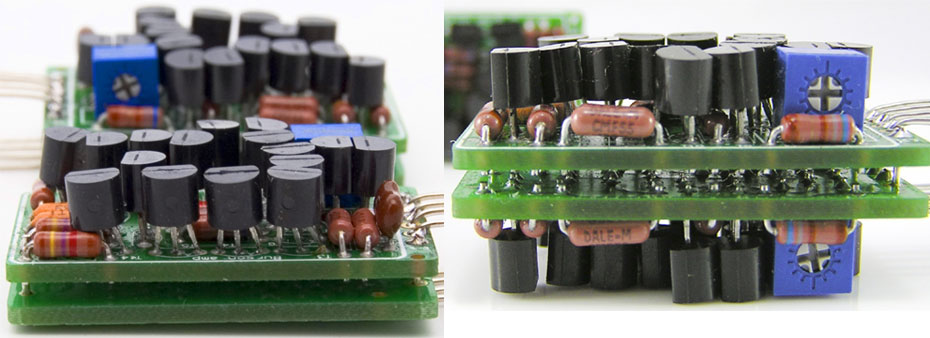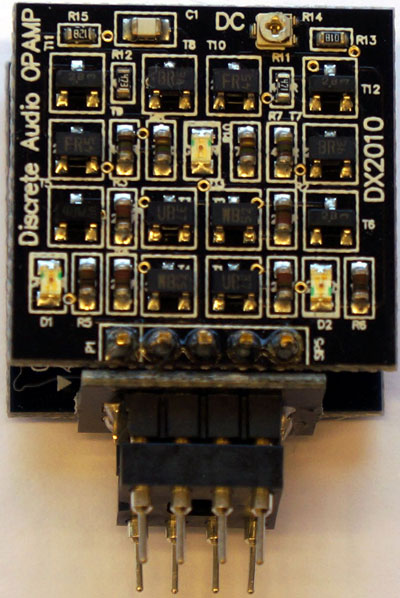5/24/2002: We have made a price correction on the product, which is mentioned toward the end of the article. Our apology to readers if this caused any confusion. -Pub.
Once again the focus of my reviewer’s attention is the affordable and unflappable Eastern Electric Minimax DAC! – this time the DAC Plus version and in particular rolling discrete Opamps. If this keeps up I may soon be able to publish a book on the subject of this DAC! I have spent an inordinate amount of time on it because I find it both wonderfully affordable and to date endlessly rewarding in terms of its escalating performance. For those first approaching the topic of Opamp rolling I recommend returning to my previous individual Audio Blast articles about both the Minimax DAC and Opamp rolling. However, the real stars of this show are the discrete Opamps.
The term “discrete” means specialized, utilized for a specific purpose. Opamps, short for “operational amplifiers,” are amplification gain stages used inside electronics. They may be used in CD Players, preamplifiers and even power amplifiers. Discrete Opamps are typically more expensive and larger than integrated circuit (IC) Opamps. My previous articles on Opamp rolling the Minimax DAC and the subsequent DAC Plus version mention the use of IC Opamps. After being encouraged by the DIY proponents of the audiophile community to consider discrete Opamps I have investigated and find them to be fantastic devices worthy of their own article.
I contacted both Burson Audio and Dexa Technologies, or more specifically Dexa’s subsidiary NewClassD, for samples of their wares to be used with the EE Minimax DAC Plus. Burson was formed in the early 1990’s by Mark Burson, who worked for three decades in the recording and broadcasting industry in Melbourne, Victoria, Australia. He assembled a team in development of the HD Opamps to address the theoretical weaknesses of IC-based Opamps. The NewClassD is smaller, better matched and more stable compared to earlier versions, and consequently is backed by a lifetime warranty. Burson Opamps are found in recording consoles, audiophile equipment, and are suitable for DIY projects.
John Delmo of Burson shared a good illustration of the importance of Opamps in an audio component, “… Opamps play a vital part in any solid state design. The Opamp is as important to a circuitry as a lens is to a camera.” I like that analogy; the image is focused by the camera lens, and similarly the power scheme inside the component is “focused” by the Opamps! It would make both common and electronic sense, then, that if the ability of the Opamp to focus the power is improved, the performance of the device is improved. That is precisely what I found in working with discrete Opamps.
Not quite half-way around the world, some 8,900 miles or 14,430 Kilometers Northwest from Burson, is the factory of NewClassD in Denmark. It began as a company developing Class D amplifiers and later expanded into digital signal clocks and low noise power boards. Discrete Opamps were an extension of such circuit design, but have become over time one of their best products. While low and midrange classed audio devices use IC Opamps, very high end equipment use discrete Opamps. As Lars Clausen of Dexa explains, “By installing a discrete Opamp you can invoke the good sound of discrete circuitry in any class of audio equipment… The target customer is tuning shops and private users who want an easy and cheap upgrade to their equipment. ”
When it comes to the Minimax DAC Plus Lars comments on the stock Opamps, “The NE5532 is a typical factory Opamp, because it has a good reputation in the professional musician community… and it’s very cheap. Here a discrete Opamp will improve the sound vastly over the NE5532.” I found that to be correct. I do not doubt Lars’s comment, “We always encourage people to try it out and if they don’t find the result convincing they will get their money back. But we have never had to return any money on this product, after thousands of units sold.” Take your pick of these two brands; either one will shame the stock IC Opamps.
How to roll discrete opamps
My comments here on the mechanics of rolling discrete Opamps are to be applied only to Burson and NewClassD products as at this time I have not tried other brands. The method of replacing the stock Opamps remains the same; one simply lifts the originals out from their sockets using an Opamp Extraction Tool and carefully places the new ones into the sockets. See my previous Opamp rolling Audio Blast articles (2010: Audio Blast, January, 2011: upgrading opamps, March, 2011: opamp rolling, October, 2011: Tube DAC Plus Review) for instruction and sources on the Extraction Tool and static discharge devices. Again, as I mentioned in my previous article, a warning; take care to grasp with the tool the actual Opamp and not the socket. Work sensibly, not impatiently. I almost never regret taking a few more minutes to get a job done well, but I have a few times deeply regretted not taking a few more minutes to do a job well. If you rush and damage a socket you will deeply regret it!
Now, pay attention!
Regarding the physical orientation of the Opamps, the adapter with the 8 pins that sit into the socket where the stock Opamp was removed has a half-moon shaped cutout on the end of the adapter located closest to pin #1. This half-moon end of the adapter is always placed to the right hand side as one faces the front of the DAC.
Take extra care and time to ensure that you are actually placing this cutout to the right hand side; do not make the mistake of looking at the adapter upside down to the right and accidentally placing it 180 degrees opposite, i.e. to the left hand side! As said in all my previous communications about Opamp rolling, this is all done at your own risk and will void the manufacturer’s warranty. So, it’s in your best interest to work slowly and make absolutely sure you have the orientation and insertion of the Opamps correct.
I also suggest you work on this when awake during the day, not late at night. Bad things happen to audiophiles switching around systems late at night when they should be sleeping. Be fresh and alert when you approach the pleasant task of swapping wires or Opamp rolling a system.
Types and placement of the discrete op-amps
Of the representative samples from Burson and Dexa NewClassD there were both single and dual discrete Opamps. Identification is once again far easier than for IC Opamps; one sees either a single or a double circuit board indicating single Opamp or dual Opamp configuration. Dexa NewClassD discrete Opamps are identified by the number of circuit boards; the dual discrete Opamp has two circuit boards.
The locations on the circuit board where they are placed:
8 pin DIP Socket Dual Opamps go into the U1 and U2 sockets
8 Pin DIP Socket Single Opamps go into the U6 and U7 sockets
They are not interchangeable, but are location-specific. Use them only where indicated by the manufacturer.
- (Page 1 of 3)
- Next page →



